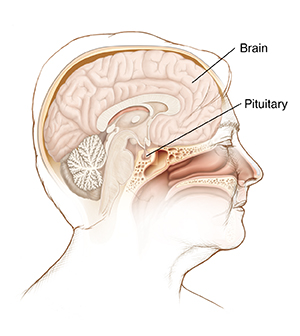What are pituitary tumors?
A pituitary tumor is an abnormal growth in the pituitary gland. The pituitary is a small gland in the brain. It is located at the base of the brain, behind the back of the nose. It makes hormones that affect many other glands and many functions in your body. Most pituitary tumors are not cancer (benign). They don’t spread to other parts of your body. But they can cause the pituitary to make too few or too many hormones, causing problems in the body.

Pituitary tumors that make too many hormones will often cause other glands to make more hormones. That will cause symptoms linked to each of the specific hormones. Many pituitary tumors will also press against the nearby optic nerves. This can cause vision problems.
Most pituitary tumors don’t cause symptoms. So they are not diagnosed. Or they are found only during routine brain imaging or blood tests. About 1 in 4 people may have small pituitary tumors without knowing it.
Below are the main types of benign pituitary tumors.
Nonfunctional adenomas (null cell adenomas)
These tumors are the most common type. They don’t make extra hormones. You may not have any symptoms until the tumor is a certain size. When the tumor is big enough, it may cause headaches and vision problems. Large pituitary tumors can put pressure on normal pituitary cells. This leads to symptoms caused by decreased hormone production.
Prolactin-producing tumors (prolactinomas)
These benign tumors are also common. They make too much prolactin. If you are a woman, high prolactin levels can make your menstrual period irregular, or even stop your period. These tumors can also cause you to make breastmilk, even if you are not pregnant or nursing. If you are a man, you may have erectile dysfunction or a lack of interest in sex. You may also have enlarged breasts, a low sperm count, or less body hair. In time, you may have headaches and vision problems.
ACTH-producing tumors
These tumors make too much ACTH (adrenocorticotropic hormone). This hormone stimulates the adrenal gland to make steroids that affect metabolism. These are called glucocorticoids (cortisol). They reduce redness and swelling (inflammation) all over the body. They also slow down your immune system. Too much ACTH can cause Cushing disease. This disease causes fat buildup in your face, neck, back, belly (abdomen), and chest. Also your arms and legs tend to become thin. You may also have purple stretch marks and high blood pressure. These tumors can also weaken your bones. Additionally, it can cause diabetes and hypertension.
Growth hormone-producing tumors
These tumors make too much growth hormone. In children, too much growth hormone stimulates the growth of almost all the bones in the body. When that occurs, the result is called gigantism. Gigantism can include increased height (over 7 feet), very quick growth, joint pain, and heavy sweating. In adults, too much growth hormone causes a condition called acromegaly. It may include:
-
Extra growth in the skull, hands, and feet
-
Deepened voice
-
A change in the facial appearance because of extra growth in the facial bones
-
A wide spacing of teeth because of the growth of facial bones
-
Joint pain
-
Snoring or sleep apnea
-
Diabetes or impaired glucose tolerance
-
High blood pressure from enlargement of the heart muscle and fluid retention
Other hormone-producing tumors
Thyroid-stimulating hormone-producing tumors
These tumors are fairly rare. They make too much thyroid-stimulating hormone. Too much of this hormone leads to increased activity of the thyroid and symptoms of hyperthyroidism. These include weight loss, a fast heartbeat, and sweating. This is a very rare pituitary condition. Healthcare providers often treat people for an overactive thyroid and only diagnose a thyroid-stimulating tumor after the treatment was unsuccessful, or the person has headaches or other hormonal problems.
Gonadotroph adenomas
These tumors are extremely rare. They release excess hormones that stimulate the ovaries or testes.
What causes pituitary tumors?
Experts don't know what causes these tumors. But some syndrome conditions, such as multiple endocrine neoplasia type I (MEN 1) may raise your risk. This condition is passed down through families (inherited).
What are the symptoms of pituitary tumors?
Symptoms depend on the type of tumor and the area of the pituitary gland that is affected. These tumors can lead to symptoms caused by too much or too little of the pituitary hormones. Each person’s symptoms may vary.
The symptoms may also look like other health problems. Always see your healthcare provider for a diagnosis.
How are pituitary tumors treated?
Treatment will depend on your symptoms, age, and general health. It will also depend on how severe the condition is.
Treatment may include:
-
Surgery to remove the tumor. Surgery is often a better choice for smaller tumors.
-
External radiation (external beam therapy). This treatment sends high levels of radiation right to the tumor cells. Special shields may be used to protect the tissue around the treatment area. These treatments are painless and often last a few minutes.
-
Radiosurgery (stereotactic radiosurgery) or gamma knife treatment. This is often 1 high dose of radiation sent right into the tumor tissue. It causes less damage to nearby tissues. It is not actually surgery. But like surgery, it is a 1-session treatment that removes the tumor.
-
Medicine. Different types of medicine may be used to control how much growth hormone, prolactin, or other hormone is made by the tumor.